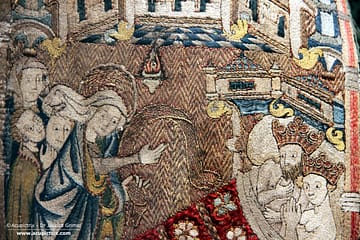Last month, we looked at some early 15th-century embroidery from Venice, Italy. You can read about it here: the Cope of Pope Gregory XII, further early 15th-century embroidery from Venice, and a tutorial. This week, we will look at a Venetian piece from the second half of the 15th century. It features some lovely embroidery techniques that would work well for modern goldwork. And the embroidery background is a bit unusual as well. Instead of using a diaper pattern, it is made of floral motifs stitched directly on coloured silk. Let’s have a look!

I saw the above chasuble at the exhibition in Castello del Buonconsiglio in 2019. The exhibition presented an overview of medieval goldwork embroidery made in Italy, complemented by pieces obtained by trade from Northern Europe. The chasuble is kept and still being worn once a year (!) at the parish church of Azzone, near Bergamo, in the Scalve Valley. The valley came under Venetian rule in 1427, and this probably explains why this piece of Venetian embroidery can be found in Azzone.
The chasuble has an embroidered orphrey cross on the front and an embroidered orphrey column on the back. Since the figures on the front could not be identified, the exhibition displayed the back. Here we see John the Evangelist at the top, followed by a male martyr with a palm branch and an architectural model (According to the literature, it is a church; however, it looks more like a castle to me), and the figure at the bottom is Saint Barbara with her tower. Saint Barbara is the patron saint of miners. The Scalve Valley was famous for its iron ore mines.

The embroidery is executed on a layer of silk backed with linen for the background and a layer of linen for the figures. The heads were embroidered separately. The finished orphrey column was stiffened with cardboard. The orphreys measure about 33 x 12 cm.

The embroidery is a rather simple, yet very effective, affair. The figures stand on a floor made of laid, shaded silk, couched down with a trellis. By having the lighter colour at the front and the darkest colour at the back, the embroiderer created a sense of depth. The undergarment of the martyr is stitched in a similar way. This time, the laid silk is couched down horizontally. The cloak consists of horizontally laid pairs of gold thread, which are couched down with white silk. Folds are accentuated with couched coloured silk. The heads are stitched in split stitch.
The background treatment behind the figures is quite special. The coloured silken background is part of the design. It is covered with the obligatory arch under which the saint stands. The background is further filled in with tendrils and floral elements. These are made by couching down a pair of gold threads and filling in some elements with shaded satin stitch. The frame around the orphrey panel consists of a very simple padded basket weave over two padding threads (over three is probably more common).
All in all, the embroidery techniques used (laid work instead of brick stitching for the undergarments, simple monochrome couching for the cloaks instead of or nué, embroidered coloured silk for the background instead of a diaper pattern, etc.) are simple and far more speedy to execute than or nué, brick stitching and diaper couching. This likely means that these embroideries were not as expensive as the ones we investigated last month.
Literature
Prá, Laura Dal; Carmignani, Marina; Peri, Paolo (Eds.) (2019): Fili d’oro e dipinti di seta. Velluti e ricami tra Gotico e Rinascimento. Trento: Castello del Buonconsiglio.



0 Comments